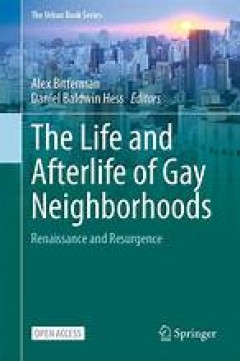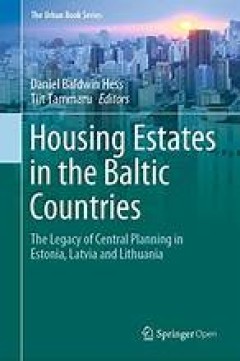Filter by

Healers on the Colonial Market : Native Doctors and Midwives in the Dutch Eas…
Healers on the Colonial Market is one of the few studies on the Dutch East Indies from a postcolonial perspective. It provides an enthralling addition to research on both the history of the Dutch East Indies and the history of colonial medicine. This book will be of interest to historians, historians of science and medicine, and anthropologists. How successful were the two medical training pro…
- Edition
- -
- ISBN/ISSN
- 978-90-04-25357-5
- Collation
- x, 376 pp
- Series Title
- Verhandelingen van het Koninklijk Instituut voor Taal-, Land- en Volkenkunde, Volume: 276
- Call Number
- -

The Life and Afterlife of Gay Neighborhoods
This open access book examines the significance of gay neighborhoods (or ‘gayborhoods’) from critical periods of formation during the gay liberation and freedom movements of the 1960s and 1970s, to proven durability through the HIV/AIDS pandemic during the 1980s and 1990s, to a mature plateau since 2000. The book provides a framework for contemplating the future form and function of gay nei…
- Edition
- 1
- ISBN/ISSN
- 978-3-030-66073-4
- Collation
- oer.unej.ac.id
- Series Title
- The Urban Book Series
- Call Number
- 307

Housing Estates in the Baltic Countries
This open access book focuses on the formation and later socio-spatial trajectories of large housing estates in the Baltic countries—Estonia, Latvia, and Lithuania. It also explores claims that a distinctly “westward-looking orientation” in their design produced housing estates that were superior in design to those produced elsewhere in the Soviet Union (between 1944 and 1991, Estonia was…
- Edition
- 1
- ISBN/ISSN
- 978-3-030-23392-1
- Collation
- oer.unej.ac.id
- Series Title
- The Urban Book Series
- Call Number
- 303

Housing Estates in Europe
This open access book explores the formation and socio-spatial trajectories of large housing estates in Europe. Are these estates clustered or scattered? Which social groups originally had access to residential space in housing estates? What is the size, scale and geography of housing estates, their architectural and built environment composition, services and neighbourhood amenities, and metro…
- Edition
- 1
- ISBN/ISSN
- 978-3-319-92813-5
- Collation
- oer.unej.ac.id
- Series Title
- The Urban Book Series
- Call Number
- 303

Housing Estates in Europe
- Edition
- -
- ISBN/ISSN
- 9783319928135
- Collation
- -
- Series Title
- -
- Call Number
- -
- Edition
- -
- ISBN/ISSN
- 9783319928135
- Collation
- -
- Series Title
- -
- Call Number
- -

Habitats and Biota of the Gulf of Mexico: Before the Deepwater Horizon Oil Spill
- Edition
- -
- ISBN/ISSN
- 9781493934478
- Collation
- -
- Series Title
- -
- Call Number
- -
- Edition
- -
- ISBN/ISSN
- 9781493934478
- Collation
- -
- Series Title
- -
- Call Number
- -

Authoring the self :self-representation, authorship, and the print market in …
- Edition
- -
- ISBN/ISSN
- -
- Collation
- -
- Series Title
- -
- Call Number
- -
- Edition
- -
- ISBN/ISSN
- -
- Collation
- -
- Series Title
- -
- Call Number
- -

Musculoskeletal Diseases 2021-2024: Diagnostic Imaging
This open access book focuses on imaging of the musculoskeletal diseases. Over the last few years, there have been considerable advances in this area, driven by clinical as well as technological developments. The authors are all internationally renowned experts in their field. They are also excellent teachers, and provide didactically outstanding chapters. The book is disease-oriented and cover…
- Edition
- -
- ISBN/ISSN
- 978-3-030-71281-5
- Collation
- -
- Series Title
- -
- Call Number
- -

The Life and Afterlife of Gay Neighborhoods: Renaissance and Resurgence
This open access book examines the significance of gay neighborhoods (or ‘gayborhoods’) from critical periods of formation during the gay liberation and freedom movements of the 1960s and 1970s, to proven durability through the HIV/AIDS pandemic during the 1980s and 1990s, to a mature plateau since 2000. The book provides a framework for contemplating the future form and function of gay nei…
- Edition
- -
- ISBN/ISSN
- 978-3-030-66073-4
- Collation
- -
- Series Title
- -
- Call Number
- -

Diseases of the Abdomen and Pelvis 2023-2026
- Edition
- -
- ISBN/ISSN
- 978-3-031-27354-4
- Collation
- -
- Series Title
- -
- Call Number
- -
- Edition
- -
- ISBN/ISSN
- 978-3-031-27354-4
- Collation
- -
- Series Title
- -
- Call Number
- -
 Computer Science, Information & General Works
Computer Science, Information & General Works  Philosophy & Psychology
Philosophy & Psychology  Religion
Religion  Social Sciences
Social Sciences  Language
Language  Pure Science
Pure Science  Applied Sciences
Applied Sciences  Art & Recreation
Art & Recreation  Literature
Literature  History & Geography
History & Geography